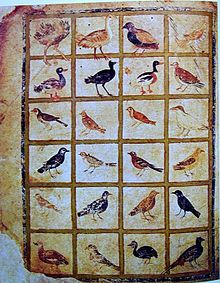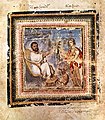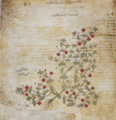Vienna Dioscurides

TheVienna DioscuridesorVienna Dioscoridesis an early 6th-centuryByzantineGreekilluminated manuscriptof an even earlier 1st century AD work,De materia medica(Περὶ ὕλης ἰατρικῆς: Perì hylēs iatrikēs in the originalGreek) byPedanius Dioscoridesinuncial script.It is an important and rare example of alate antiquescientific text. After residing inConstantinoplefor just over a thousand years, the text passed to theHoly Roman EmperorinViennain the 16th century, a century afterthe city fellto theOttoman Empire.
The 491vellumfoliosmeasure 37 cm (15 in) by 30 cm (12 in) and contain more than 400 pictures of animals and plants, most done in a naturalistic style. In addition to the text by Dioscorides, the manuscript has appended to it, theCarmen de herbisattributed toRufus,a paraphrase of an ornithological treatise by a certain Dionysius, usually identified withDionysius of Philadelphia,and a paraphrase ofNicander's treatise on the treatment of snake bites.
History[edit]

The manuscript was created in about 515 AD in theByzantine(Eastern Roman) Empire's capital, Constantinople, for a resident Byzantine imperial princess,Anicia Juliana,the daughter ofAnicius Olybrius(one of the last of theWestern Roman Emperors). The manuscript is accordingly now called theJuliana Anicia Codexby scholars.[1]Although it was created as a luxury copy, in later centuries it was used daily as a textbook in the imperial hospital of Constantinople, and a medieval note records that a Greek nurse there, named Nathanael, had it rebound in 1406.[2]
Throughout the Byzantine period the manuscript was used as the original for copies of the work that were given to foreign leaders, including the Arabic edition ofAbd al-Rahman IIIof Spain for the creation of which the Byzantine EmperorConstantine VIIsent a Greek copy and a translator.[3]A note recording the name of one Michael of theVarangian Guardis also found in the text.[2]
The manuscript was restored and a table of contents and extensivescholiaadded in ByzantineGreek minuscule,by thepatriarchalnotaryJohn Chortasmenosin 1406.[4]In the mid-15th century, it was used to create thePope Alexander VIIDioscorides, now in theVatican Library,by the monks ofSt. John the Baptist Greek orthodox monasteryin Constantinople. After thefall of Constantinoplein 1453 a subsequent owner handwrote each plant's name inArabicandHebrew.[4][5]The manuscript, still inIstanbula century after the fall of the city, was purchased fromMoses Hamon,the Arabic-speaking, Jewish physician to sultanSuleiman the Magnificent,by the Flemish diplomatOgier Ghiselin de Busbecq,who was in the employ of EmperorFerdinand Iof theAustrian Habsburgs.The manuscript is now held among themanuscriptsof theAustrian National Library(German:Österreichische Nationalbibliothek) inVienna,where it is identified as theCodex Vindobonensismed. gr. 1.The manuscript was inscribed onUNESCO'sMemory of the World ProgrammeRegister in 1997 in recognition of its historical significance.[6]
Illustrations[edit]

The manuscript has 383 extant full-page illustrations of plants out of the original 435 illustrations. The illustrations fall into two groups. There are those that faithfully follow earlier classical models and present a quite naturalistic illustration of each plant. There are also other illustrations that are more abstract. The majority of the illustrations were painted in a naturalistic style so as to aid a pharmacologist in the recognition of each plant. However, it is believed that these illustrations were made as copies of an earlier herbal and were not drawn from nature.
In addition to the illustrations of the text, the manuscript contains severalfrontispiecesin the form of a series of full-page miniatures. Of special note is thededication miniatureportrait of Anicia Juliana on folio 6 verso. The manuscript was presented to Anicia out of gratitude for her funding the construction of a church in the suburbs ofConstantinople.This portrait is the oldest extant dedication portrait. The portrait has Anicia seated in a ceremonial pose distributing alms. She is flanked by personifications ofMegalopsychia(magnanimity) andPhronesis(prudence). At her feet, another personification, labeled "Gratitude of the Arts", kneels. Aputtoholds a dedication copy up to Anicia. Anicia and her attendants are enclosed within an eight-point star within a circle all formed of intertwined rope. Within the outer spandrels of the star areputti,done ingrisaille,working as masons and carpenters. This miniature is an altogether original creation and, with the inclusion of the personifications and the putti, shows the endurance of the classical tradition in Constantinople, despite the fact that Anicia herself was a pious Christian.

The series of frontispieces in the manuscript begins with two full-page miniatures, each having a group of seven notedpharmacologists.In the second picture (folio 3 verso, seehere), the most prominent and only one sitting on a chair isGalen.He is flanked by three pairs of other physicians, seated on stones or the ground. Closest to Galen areCrateuasandDioscurides.The second pair areApollonius MysandNicander.Farthest from Galen areAndreasandRufus of Ephesus.Each of the figures is a self-contained portrait and was probably modeled on authors' portraits from the various authors' treatises. The seven figures are contained within an elaborate decorated frame. The background is solid gold, which places the figures in an abstract space. This is the earliest known manuscript to use asolid gold background.
Following the two miniatures of seven pharmacologists, there are twoauthor portraits.In the second portrait (seehere), Dioscurides sits writing in a codex on his lap. He is shown in profile, which corresponds to the portrait in the previous miniature. It is possible that there was a tradition based on Dioscurides' life portrait that the images are based on. In front of Dioscurides is an artist, seated at a lower level, painting an illustration of themandrakeroot. He is painting from nature. The mandrake root he is looking at is held by the personification ofEpinoia(the power of thought). There is architectural background consisting of a colonnade with a central niche.
The paraphrase of the treatise onbirdsby Dionysius is in three books. The first two books have illustrations of the birds inserted into the text columns without frame or background (for example, seehere). The third book has 24 birds arranged in a grid on a full-page miniature (see illustration above). The birds portrayed throughout the treatise are of high artistic merit and are faithful to nature in form and color. Most of the birds are easily identifiable. Some of the birds contained in the full-page miniature in the third book are not described in the text of the paraphrase. It is probable that these illustrations are based on the illustrations from an older, different treatise, possibly that ofAlexander of Myndus.This manuscript, however, is the oldest surviving illustrated treatise on birds.
Gallery[edit]
-
Peacock endpapers
-
Folio 4v,author portrait
-
Folio 5v, author portrait
-
Folio 6v, donation portrait of Anicia Juliana
-
Folio 29v,Plantago lanceolata(lamb's tongue)
-
Folio 148v,Viola odorata(violet)
-
Folio 167v,Cannabis sativa(hemp)
-
Folio 391v, coral
-
Folio 475r, birds
-
Folio 39v,Anagallis arvensis(scarlet pimpernel)
References[edit]
Notes[edit]
- ^The 1500th Anniversary (512-2012) of the Juliana Anicia Codex: An Illustrated Dioscoridean Recension. Jules Janick and Kim E. Hummer. Chronica horticulturae. 52(3) 2012 pp. 9-15
- ^abMazal, Otto. "Der Wiener Dioscurides" vol. 1, p. 16
- ^Mazal, Otto. "Der Wiener Dioscurides" vol. 2, p. 89
- ^abJanick, Jules, and John Stolarczyk. "Ancient Greek illustrated Dioscoridean herbals: origins and impact of the Juliana Anicia Codex and the Codex Neopolitanus." Notulae Botanicae Horti Agrobotanici Cluj-Napoca 40.1 (2012): 09.
- ^Tiltman, John H. (Summer 1967). "The Voynich Manuscript:" The Most Mysterious Manuscript in the World "".NSA Technical Journal.XII(3).
- ^"Vienna Dioscurides".UNESCO Memory of the World Programme. 2009-02-12.Retrieved2009-12-11.
Sources[edit]
- Walther, Ingo F. and Norbert Wolf.Codices Illustres: The world's most famous illuminated manuscripts, 400 to 1600.Köln, TASCHEN, 2005.
- Weitzmann, Kurt.Late Antique and Early Christian Book Illumination.New York: George Braziller, 1977.
Further reading[edit]
- Leslie Brubaker, "The Vienna Dioskurides and Anicia Juliana" inByzantine Garden Cultureed. Antony Robert Littlewood, Henry Maguire, and Joachim Wolschke-Bulmahn (Washington, D.C.: Dumbarton Oaks Research Library and Collection, 2002).
- Weitzmann, Kurt,ed.,Age of spirituality: late antique and early Christian art, third to seventh century,no. 179, 1979,Metropolitan Museum of Art,New York,ISBN9780870991790;full text available online from The Metropolitan Museum of Art Libraries
- Lazaris, Stavros, "L'illustration des disciplines médicales dans l'Antiquité: hypothèses, enjeux, nouvelles interprétations",in:La Collezione di testi chirurgici di Niceta (Firenze, Biblioteca Medicea Laurenziana, Plut. 74.7). Tradizione medica classica a Bisanzio,M. Bernabò (ed.), Roma, 2010, pp. 99–109
- Lazaris, Stavros, "L'image paradigmatique: des Schémas anatomiques d'Aristote au De materia medica de Dioscoride",Pallas,93 (2013), pp. 131–164
- 515
- 6th-century illuminated manuscripts
- Biology books
- Herbals
- Scientific illuminated manuscripts
- Ancient Roman medicine
- Byzantine medicine
- Memory of the World Register
- Manuscripts of the Austrian National Library
- Byzantine illuminated manuscripts
- Constantine VII
- Pope Alexander VII
- Ferdinand I, Holy Roman Emperor
- Putti










